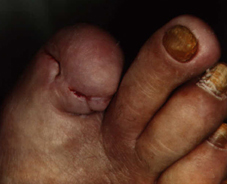Practice of Diabetology Carola Zemlin M.D., Wanzleben/Germany
Anamnesis
64 years old, male, type 2 diabetes mellitus, diabetes diagnosis 1969, insulin therapy with two injections of combination insulin 30/70. Arterial occlusive disease and concomitant neuropathy, polyneuropathy and coronary heart diesease. Because of a recurrent onychitis at the 1st right great toe with osteomyelitis the patient underwent a surgical revision (removal of the osteomyelitic end phalanx, partial resection of the great toe). The postsurgical wound treatment is carried out stationary for 22 days. Local toxicant substances and foot bathes were not used, but alginates soaked with Ringer´s solution. However no complete wound closure was achieved. Mainly it comes to exudation from the depth again and again, because the wound edges whealed quickly (so-called pseudo-closure).
Actual findings at 1998/09/13
Wound edges are whealed in the resection area, the exploration in the depth shows a 1 cm deep wound.
Refreshening of the wound edges and scraping out the wound with a sharp spoon, there is discharge of malodorous secretion and residues of alginate. Daily application of sterile LIGASANO® white packs soaked with Ringer´s solution. Complete closure after 21 days.
Study about the use of LIGASANO® white as initial wound dressing at foot disease caused by diabetics, of Carola Zemlin, M.D., internist/diabetologist. For the evaluation of the study please click here.


